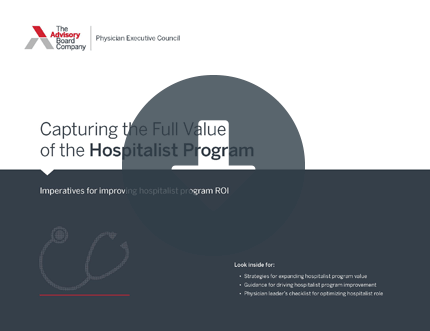Auto logout in seconds.
Continue LogoutIn partnership with Commonwealth Care Alliance (CCA), Boston Medical Center (BMC) crafted a four-part hospitalist model that may prove more effective than traditional hospitalist care for treating complex patients, Caroline Berchuck writes for the Harvard Business Review.
According to Berchuck, the traditional hospitalist model typically relies on physicians within the hospital who have expertise in hospital care for admitted patients. But often, hospitalists have "little to no prior experience with the patients they treat."
On the one hand, Berchuck writes, "data ha[ve]shown that this model can lead to lower average length of stay without increasing costs."
However, it's unknown whether hospitalists might "achieve better patient-centered outcomes" if they had a better understanding of patients' individual medical histories, Berchuck writes. The lack of familiarity with a patient's history could be particularly important for patient with complex care needs who "typically have complicated medical histories, functional limitations or disabilities, numerous medications prescribed by multiple outpatient providers, and social drivers of illness," Berchuck writes.
With these questions in mind, CCA and BMC launched a hospitalist service with physicians and mid-level providers who specialize in complex care.
How BMC's complex care hospitalist model works
BMC's new hospitalist model for complex care centers on four key components.
1. Frequent communication with patients' primary care team: BMC's complex care hospitalist team "frequently" communicates with patients' primary care team as soon as a patient is admitted, provides updates throughout their hospitalization, and consults with the primary care team regarding discharge planning.
2. Continuity of care: All patients admitted to BMC's complex care services are located within the same unit and have a dedicated, consistent staff of nurses and hospitalists, Berchuck writes. To ensure a safe discharge, a nurse-led transition-of-care team coordinates with hospital staff, hospitalists, and primary care teams regarding discharge plans.
3. Identify social determinants of health: BMC trains its complex care team in social determinants of health and how to identify what a patient may need, as social needs can have a significant effect on health outcomes. For example, if a diabetic patient has difficulty accessing food, the complex care team would coordinate with a food bank or Meals on Wheels to provide the patient with food to meet their dietary needs when they return home, Berchuck writes.
4. Specialization in complex care. BMC's complex care team employs providers with expertise in caring for complex patients, Berchuck writes. The hospitalists on the complex care team are also trained in acute care medicine and caring for the needs of complex patients. The nurses are trained in nursing care for complex patients, such as caring for patients with disabilities and functional limitations.
Results
BMC has just started assessing the results of the program, but the "initial results are promising," Berchuck writes. BMC has observed five patients admitted to hospitalist/general medicine services and 10 admitted to complex care services.
Patients discharged from the complex care service had a 20% 30-day readmission rate, with 20% going to the ED within 30 days after discharge, while those discharged from the hospitalist/general medicine services had an 80% readmission rate with the remaining 20% returning to the ED within 30 days. The hospital is currently conducting an evaluation of over 1,000 admissions, according to Berchuck.
"[I]n an era where hospital costs and outcomes, particularly for high-cost, high-need patients, are more relevant than ever," Berchuck writes, "the complex care hospitalist model offers an achievable and replicable option for value-based hospital medicine" (Berchuck, Harvard Business Review, 10/9).
Get 4 imperatives to capture the full value of the hospitalist program
In most hospitals, hospitalists care for over 50% of patients, but few hospitalist programs have been fully leveraged to advance outcomes.
To help hospitalist programs realize their full potential, we break down four imperatives to help physician leaders overcome the major, consistent challenges hospitalist programs face.
Don't miss out on the latest Advisory Board insights
Create your free account to access 1 resource, including the latest research and webinars.
Want access without creating an account?
You have 1 free members-only resource remaining this month.
1 free members-only resources remaining
1 free members-only resources remaining
You've reached your limit of free insights
Become a member to access all of Advisory Board's resources, events, and experts
Never miss out on the latest innovative health care content tailored to you.
Benefits include:
You've reached your limit of free insights
Become a member to access all of Advisory Board's resources, events, and experts
Never miss out on the latest innovative health care content tailored to you.
Benefits include:
This content is available through your Curated Research partnership with Advisory Board. Click on ‘view this resource’ to read the full piece
Email ask@advisory.com to learn more
Click on ‘Become a Member’ to learn about the benefits of a Full-Access partnership with Advisory Board
Never miss out on the latest innovative health care content tailored to you.
Benefits Include:
This is for members only. Learn more.
Click on ‘Become a Member’ to learn about the benefits of a Full-Access partnership with Advisory Board
Never miss out on the latest innovative health care content tailored to you.

